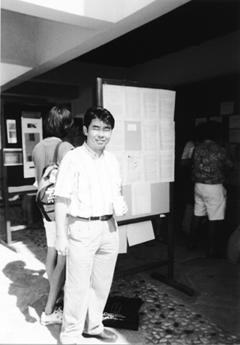
Visitor: Kentaro Onizuka (Parallel Application TRC Laboratory) Period: June 21-25, 1997 (5 days) Place (attended conference): The Fifth International Conference on Intelligent Systems for Molecular Biology (ISMB '97) (Greece)
The Fifth International Conference on Intelligent Systems for Molecular Biology (ISMB '97) was held from June 21 to 25.
The ISMB was first held at the National Institute of Health (NIH) in Washington DC in 1993 through invitation by Larry Hunter et al. at NIH. Since then, ISMB has been held in Stanford (USA), Cambridge (UK), St. Louis (USA), and then this time in Halkidiki, a resort in Northern Greece.
Halkidiki is located about 100 km southeast of Thessaloniki, the second largest city in Greece in ancient Macedonia of Alexander the Great, and the conference was held at a hotel built on the central of three peninsulas.
Facing to the motionless Aegean Sea and looking at the setting sun from my ocean-front room of the hotel made me ponder and explore various ideas within myself. Greece, which plateaued in natural philosophy 2,500 years ago, is still the best place to think.
A taxi driver maintained while leaving Thessaloniki and the conference site, ³No cars made in Greece are running, but we have the history.² Modern advanced countries, with goals of economical growth and lavish material civilization may be seen just as one frame of history from the eyes of the people from a country with such a glorious past.
The fifth ISMB, held in Greece, offered a good opportunity for researchers tossed about in the middle of the explosive growth of computing environments and network environments to regain a free sense of contemplation.
In 1993 when the First ISMB was held, molecular biology was considered to be the most promising application domain among artificial intelligence researchers, and artificial intelligence was considered to be able to solve all problems concerning molecular biology for researchers. So the First ISMB was stimulating for both artificial intelligence researchers and molecular biology researchers, because they were able to come together and discuss intently the fusion of these two fields. At the Second ISMB, however, the mood was changed. Molecular biology researchers realized that artificial intelligence was not a dream-like technology, and information-oriented researchers realized that enormous efforts were required for molecular biology to be an application domain. What remained were those who can endure stoic research and can gather and electronize data from the base to establish techniques to use and retrieve information on networks. Problems such as 3-dimensional protein structure prediction, the metabolic pathway problem, and the control mechanism for division of cells were still difficult even for computer scientists.
In this Conference, there was no report mentioning the application of artificial intelligence research or advanced information science to molecular biology. Reports focused on the creation of databases and the development of document content analysis systems. This conference was unsatisfactory, since there was no report on leading-edge or challenging research.
Having participated in this Conference, I visited ETH SCSC (Swiss Center for Scientific Computing) in Zurich, Switzerland, to discuss with computational chemistry researchers. Some of them were engaged in protein sequence analysis in molecular biology. These researchers do not belong to such communities as the ISMB Conference and carry out their research independently. It might be good, but the community of researchers participating in ISMB is steadily improving the research environment and infrastructure for research activities. We benefit from our relationship with them. Thatıs an important point.
The dream is not over yet. This field, which seems to be shriveling from the forefront, may overcome the time of trial and emerge again like a phoenix. Once more advanced computing network resources are realized, results from steady research would be quite useful. The number of participants in ISMB is increasing year after year. The existence of computer researchers who entered in this field at earlier times enticed many computer researchers who had nothing to do with biology into this field. Similarly, biologists who never used computers started to use them. New research buds have started to grow. This meeting in Greece should leave something for us. This travel made me think in a variety of ways, since this field is now in the middle of a transition period, preparing to take off again after the period of stagnation which followed the bullish period several years ago.
